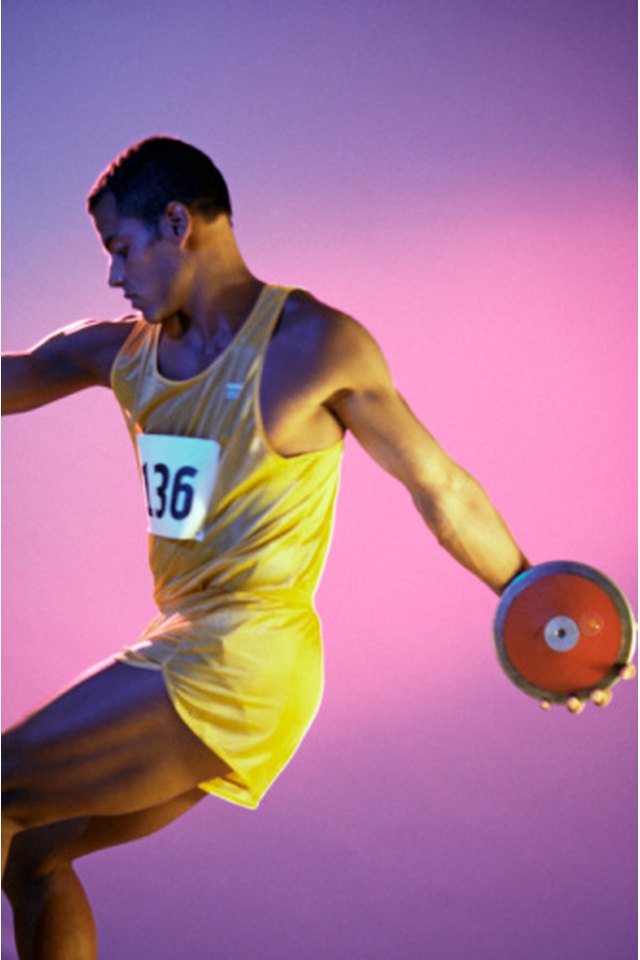Track and Field Throwing Events

Whether it’s high school track and field or an IAAF sanctioned event, throwing events are often the highlight of track and field competitions. Throwing events are amongst the oldest in track and field athletics and some predate events like sprints, pole vault, long jump and high jump. Where ancient Greek competitors once threw rocks and spears, they now use the shot and javelin. Throwing events require great strength and throwers are usually the biggest athletes in any athletic competition. There are four recognized throwing events in modern track and field athletics: the shot put, the discus, the javelin and the hammer.
What is shot put?
The shot put has been an Olympic sport since 1896, but the world championships for it started in 1866. Shot put event athletes must push or put a heavy metal ball called a shot out of a 7-foot diameter concrete throwing circle. The shot weighs 16 lbs. in men's competitions and 8.8 lbs. for women. The two main methods used in shot put are the spin and the glide. Most top putters use the spin method. The men's world record for the shot is 23 meters, 38 centimeters -- or 76 feet and 8 ¼ inches, and is held by American Ryan Crouser, as of 2023 The women's world record of 22 meters, 63 centimeters -- or 74 feet and 3 inches, is held by Natalya Lisovskaya of Russia.
What is discus?
Discus throwing has been a sport since ancient Greece circa 708 B.C. and consists of throwing a heavy circular disc as far as possible. Up until 1906, the discuss was thrown from an elevated pedestal but modern discuss throwers use a circle similar in size and design to shot putters. Discus throwing was featured in the first of the Olympic games in 1896 and was one of the fist women's Olympic events in 1928. Men throw a discuss weighing 4 lb., 7 oz. while women's discus weighs 2 lb., 3 oz. Discus throwers use rotational throwing technique, which can see the discuss flying to distances as far as 250 feet. This is due to the aerodynamics of the shotput and the biomechanics needed to hurl a discus that far.
What is javelin?
Javelin throwing was once an integral part of ancient warfare and the farther a warrior could hurl a javelin, the greater his standing in the army. The first men's Olympic javelin event was in 1908 and in 1932 for women. Originally made of wood, modern javelins are made of metal. Men's javelins weigh 800 g and women's javelins weigh 600 g. Javelins can be thrown huge distances and have had to be redesigned as athletes were generating throws in excess of the length of modern athletics stadium. Javelin throwing is the only track and field throwing competiton that allows a run up from the starting position, which means lower body power and strength is vital.
What is Hammer Throw?
The hammer throwers of old used to throw blacksmiths hammers. The hammer used in modern competition does not really resemble a hammer and consists of a heavy metal ball and a long wire handle. The hammer is thrown from a 7-foot diameter concrete circle after the thrower has spun around three or four times. The hammer used in men's competitions weighs 16 lbs. and the hammer used by women weighs 8.82 lbs. The men's world record is held by Yuriy Sedykh and measures 86.76 meters, as of 2023. The women's world record is 82.98 meters and is held by Anita Wlodarczyk of Poland.
Writer Bio
Patrick Dale is an experienced writer who has written for a plethora of international publications. A lecturer and trainer of trainers, he is a contributor to "Ultra-FIT" magazine and has been involved in fitness for more than 22 years. He authored the books "Military Fitness", "Live Long, Live Strong" and "No Gym? No Problem!" and served in the Royal Marines for five years.
